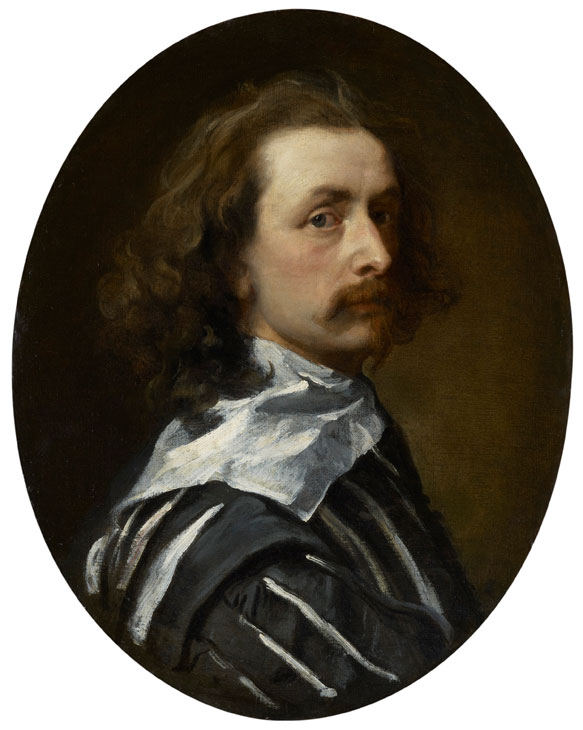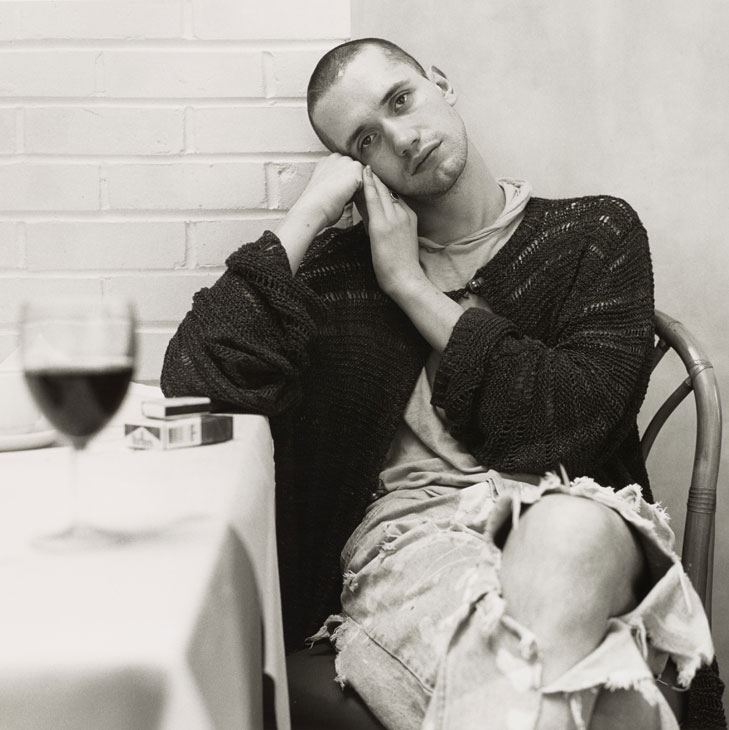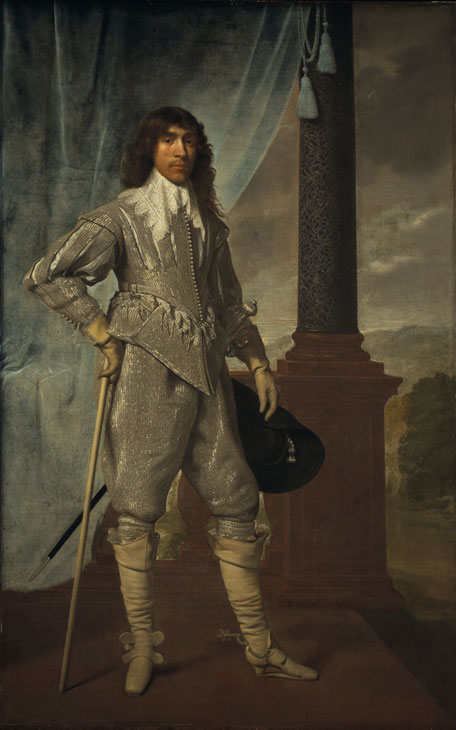Leonardo da Vinci recommended avoiding the latest dress fashions in portraits so ‘we may be spared being laughed at by our successors for the mad fashions of men and leave behind only things that may be admired for their dignity and beauty’. Sir Joshua Reynolds, likewise, preferred simple clothes to ‘those whimsical and capricious forms by which all other dresses are embarrassed’. In an early self-portrait, currently on display in ‘Looking Good: The Male Gaze from Van Dyck to Lucian Freud’ at the Scottish National Portrait Gallery, he opts for a plain blue waistcoat and informal frock coat.
The centrepiece of this exhibition is Sir Anthony Van Dyck’s final Self-Portrait (1640). Purchased in 2014 by the National Portrait Gallery, London, following a major public appeal, the painting has been styled ‘a masterpiece for everyone’ and is now at the end of a three-year tour of exhibitions on the subject of Van Dyck, image and identity, and the development of self-portraiture. Here, on its only stopover in Scotland, it prompts a series of reflections on male appearances, fashion and sexuality, from 17th-century cavaliers to the rise of the male celebrity.
Sir Anthony Van Dyck (c. 1640), Anthony Van Dyck. National Portrait Gallery, London

Van Dyck is known for his innovative new vision of fashion, which rendered obsolete the meticulous representations of pattern and ornament favoured by his predecessors in England. In this self-portrait, the artist’s highly finished facial features and intense gaze as he twists towards the viewer, contrast with the broad, impressionistic brushstrokes that depict his clothing. He also experimented with classical or pastoral costumes. A 20-year-old Lord George Stuart, 9th Seigneur of Aubigny (who was killed in the English Civil War along with his two younger brothers, also famously painted by Van Dyck) is portrayed as a shepherd in an Arcadian landscape wearing a timeless tunic and draperies. Van Dyck’s sitters could rest assured that they would not be derided by their contemporaries for being too fastidious and fashionable.
Fashion, ornament and surface decoration in dress have long been equated with the feminine, just as concern for one’s appearance has historically been linked with leisure, domesticity and a neglect of more masculine, weighty occupations. It is not surprising then that two of the most sumptuous images in the exhibition show Victorian men at ease in the sanctity of their own homes, having abandoned their formal public garb in favour of more eye-catching dressing gowns. A watercolour by Irish artist Daniel Maclise shows an unidentified man reclining in an armchair, swathed in a robe, his fashionable, patterned slipper resting on a leather pouf. He is camouflaged within his comfortable surroundings. Similarly, Andrew Geddes painted fellow Scottish artist Sir David Wilkie (1816) in a damask dressing gown, leaning on a tapestry work chair, with a Japanned screen and furniture in the background. The image represents a nexus between the domestic, feminine, fashionable and Oriental – a reflection of the cosmopolitan and artistic circles Wilkie frequented.
Sir David Wilkie (1816), Andrew Geddes. © National Galleries of Scotland

A portrait of artist Grayson Perry as his female alter-ego Claire by Richard Ansett (2014) is the sole image of a man abandoning himself entirely in public to frills and frou frou, the stereotype of female dress. Other photographs, in a section of the show exploring sexuality and gender, privilege the significance of flesh and the body over clothing. In one image from 1989, David Williams portrays dancer Michael Clark in a cafe, huddled in an oversized Eighties cardigan, looking out contemplatively, with one muscular knee protruding provocatively through ripped jeans. In Smutty (1980) by Robert Mapplethorpe, a bare-chested youth’s vulnerability is offset by his tattoos and assertive pose. Sporting heroes feature prominently in a group of ‘Male Icons’, which includes a portrait of a young David Beckham by Lorenzo Agius (1998) next to a toned bromide print of Linford Christie’s naked torso, photographed by Alistair Morrison shortly before the 1996 Olympic Games. Undoubtedly intended as a celebration of his athleticism, it is an unsettling image, especially given the media’s objectification of Christie at the time.
Michael Clark. Dancer (1989), David Williams. National Galleries of Scotland. © David Williams

As the exhibition suggests, men have been far more concerned with fashion and physical appearances than is often acknowledged. Yet many of the subjects here are artists, musicians or designers – individuals who tend to rise above social conventions. With this emphasis on free spirits and self-expression, it is easy to forget that clothing is often a means of achieving anonymity. This was illustrated in Grayson Perry’s TV series All Man (Channel 4, 2016), by the homogeneity of city workers’ suits and the predilection of young men on warring council estates in West Lancashire for The North Face clothing. The imperative felt by many men to conform through their appearances is alluded to in a video and soundscape made in response to the exhibition by Scottish band, Young Fathers. Band member Graham ‘G’ Hastings once described a life-changing moment at an under-16s hip hop night in Edinburgh: ‘I knew this was my way out from having to wear certain clothes and talk in a certain way.’
This small exhibition is brimming with ideas about changing masculinities, and one of its achievements is to lead us back to the permanent collections of the Scottish National Portrait Gallery with fresh eyes. ‘Looking Good’ offers glimpses of flamboyance, such as Daniel Mytens’ swagger portrait of James Hamilton, 1st Duke of Hamilton (1629), but no one shouts to be looked at quite as loudly as his later compatriot, Kenneth Sutherland, 3rd Lord Duffus, whose portrait by Richard Waitt (c. 1712) hangs outside in the main galleries. Clad in ornate and politically-charged Highland dress, this ex-Royal Navy captain who joined the Jacobite uprising exceeds most others in his sartorial exuberance and is eminently worthy of closer inspection.
James Hamilton, 1st Duke of Hamilton, 1606–49. Royalist (1629), Daniel Mytens. National Galleries of Scotland. Photo: Antonia Reeve

‘Looking Good: The Male Gaze from Van Dyck to Lucian Freud’ is at the Scottish National Portrait Gallery, Edinburgh, until 1 October 2017.



